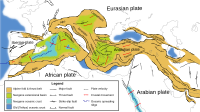
Photo from wikipedia
Abstract Late Cretaceous felsic and latest Cretaceous-Paleogene basaltic volcanic rocks are exposed throughout the Kyrenia Range, N Cyprus. Field mapping of the key, well-exposed western range indicates that the felsic… Click to show full abstract
Abstract Late Cretaceous felsic and latest Cretaceous-Paleogene basaltic volcanic rocks are exposed throughout the Kyrenia Range, N Cyprus. Field mapping of the key, well-exposed western range indicates that the felsic volcanics are mainly crop out in the southerly, frontal part of the range, separated from the latest Cretaceous-Paleogene basaltic volcanics farther north by a thrust. New U-Pb zircon dating of the felsic volcanics indicates a primary age of c. 74.0 Ma (Late Campanian). The felsic volcanics are characterised by evolved compositions that were probably generated in an extensional subduction-related setting. Their relatively low Nb and Y but high Rb concentrations, together with characteristic Th/Ta ratios (6–20), suggest a mature continental arc setting. The latest Cretaceous-Paleogene basaltic volcanics have mainly within-plate chemical characteristics (in the east), although some have a subordinate subduction influence; e.g. negative Nb (in the west). Sr-Nd-Hf isotopic signatures (i.e. high positive eNd(t) and eHf(t) values) suggest derivation of the basalts from several OIB-like mantle sources, with probable involvement of a crustal (recycled) component (i.e. elevated Nb/Y ratios). Comparisons with SE Turkey, where Late Cretaceous arc-related granitic rocks are widely developed, suggest that the Kyrenia Range igneous rocks may have originated to the south of the Alanya metamorphic massif (N of Cyprus) and correlative continental units in SE Turkey. The latest Cretaceous-Paleogene basaltic volcanics in N Cyprus and SE Turkey (Maden Complex) are interpreted to represent incipient marginal basin formation, possibly in an oblique-convergent setting, prior to Miocene suturing with Arabia. In the light of alternatives, we infer genesis of the N Cyprus Late Cretaceous and Paleogene volcanic rocks related to stages in the development of the northerly active continental margin of the Southern Neotethys.
Journal Title: Lithos
Year Published: 2020
Link to full text (if available)
Share on Social Media: Sign Up to like & get
recommendations!